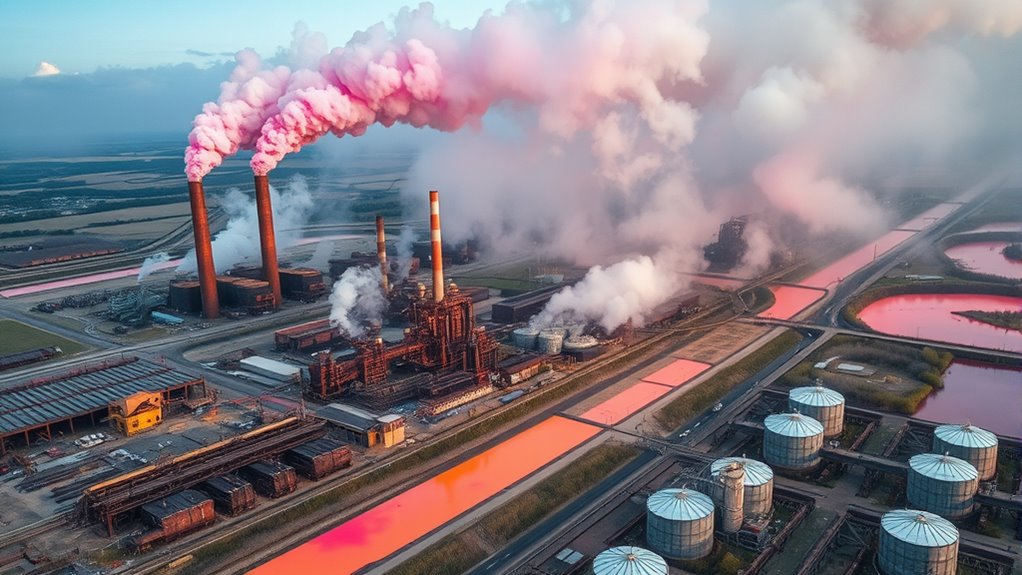Throughout history, producing pigments has impacted the environment in many ways. Ancient methods involved mining and processing natural minerals, which disturbed habitats and released harmful particles. The rise of synthetic dyes in the 19th century brought brighter colors but caused pollution and resource depletion. Modern innovations focus on eco-friendly alternatives, but traditional and industrial practices still harm ecosystems through mining, chemical waste, and pollution. To understand how these impacts evolved and what’s being done today, keep exploring this fascinating topic.
Key Takeaways
- Ancient extraction methods minimized environmental impact but were labor-intensive and limited in scale.
- Synthetic dyes increased color diversity but caused significant water pollution and resource depletion.
- Mineral mining for pigments disrupted habitats, introduced toxic particles, and contaminated ecosystems.
- Chemical manufacturing of pigments released hazardous waste, polluting air, water, and soil.
- Modern innovations focus on eco-friendly, biodegradable, and plant-based pigments to reduce environmental harm.
Ancient Pigments and Their Extraction Methods

Ancient pigments have fascinated researchers because of the diverse methods people used to extract vibrant colors from natural sources. You’ll discover that early artisans relied heavily on natural mineral sources like ochre, malachite, and lapis lazuli. They employed traditional extraction techniques such as grinding, pounding, and washing to obtain pigments. For example, ochre was harvested from earth deposits, then crushed into fine powders for use in art and decoration. Similarly, the deep blue of lapis lazuli was mined and ground into a pigment called ultramarine. These methods were labor-intensive but effective, showcasing a deep understanding of natural resources. By utilizing these traditional techniques, ancient cultures created stunning colors without the environmental impacts associated with modern synthetic processes. Self Watering Plant Pots were not available in that era, but their concept of efficiently managing resources reflects the ingenuity of ancient extraction and utilization methods.
The Rise of Synthetic Dyes and Industrialization

The advent of synthetic dyes in the 19th century revolutionized the textile and art industries by providing brighter, more durable colors at a lower cost. However, this industrial boom introduced significant environmental challenges. Manufacturing these dyes often results in chemical runoff, polluting nearby water sources and harming aquatic ecosystems. Additionally, the production process consumes vast amounts of resources, leading to resource depletion, especially of non-renewable materials. As industries ramped up to meet demand, waste disposal became a pressing issue, with toxic chemicals sometimes released into the environment. While synthetic dyes increased accessibility and variety in color, they also contributed to long-term ecological damage. Your awareness of these impacts underscores the importance of balancing industrial progress with sustainable practices. Power consumption of dye manufacturing processes further highlights the environmental footprint associated with synthetic dyes.
Environmental Consequences of Mineral Mining

As industries expanded their use of synthetic dyes, demand for mineral-based pigments also surged, leading to increased mining activities. This growth results in significant environmental consequences. Mining operations often cause habitat disruption, destroying ecosystems and threatening local wildlife. Additionally, the extraction process can introduce harmful particles into soil and water, raising bioaccumulation concerns as toxic minerals build up in plants and animals. These contaminants can then enter the food chain, impacting both wildlife and human populations. The disturbance of land and water sources also increases erosion and sedimentation, further degrading habitats. Moreover, water contamination from mining runoff can affect nearby water bodies, impacting aquatic life and water quality. While mineral pigments have historically contributed to vibrant colors in art and industry, their extraction leaves lasting scars on the environment and raises ongoing ecological risks.
Pollution From Chemical Manufacturing Processes

Chemical manufacturing processes for pigments often release pollutants into the environment, posing serious health and ecological risks. You might not see it, but chemical waste from these factories can contaminate water, soil, and air, affecting communities and wildlife. Improper disposal or inadequate pollution control measures allow hazardous substances to seep into ecosystems, leading to long-term damage. Heavy metals, solvents, and other toxic chemicals are common byproducts, threatening public health. To mitigate these dangers, industries implement pollution control strategies like filtration, waste treatment, and emission reduction systems. However, if these measures fall short, environmental contamination persists. As someone concerned with sustainability, you should recognize the importance of strict regulation and responsible waste management to minimize the impact of chemical manufacturing on the planet. Implementing pollution control strategies effectively is essential for safeguarding ecosystems and public health.
Modern Innovations and Sustainable Alternatives

Innovations in pigment production are driving the development of more sustainable and eco-friendly alternatives. You’ll find that biodegradable pigments are gaining popularity because they break down naturally without harming the environment. These pigments often derive from renewable raw materials, reducing reliance on fossil fuels and toxic chemicals. Companies are exploring plant-based dyes and mineral pigments that are safer for ecosystems and human health. Techniques like bioengineering enable the creation of vibrant, durable colors using sustainable sources. By adopting these innovations, industries can minimize pollution and waste associated with traditional chemical processes. As consumer awareness grows, more brands are switching to eco-friendly pigments, making sustainability a key factor in production. Additionally, understanding the juice extraction process from fruits like oranges highlights the importance of efficient, natural resource use in creating sustainable products. These advancements demonstrate how modern technology can help reduce the environmental footprint of pigments without sacrificing quality.
The Future of Eco-Friendly Pigment Development

The future of eco-friendly pigment development holds promising potential as technological advancements continue to evolve. You’ll see a shift toward biodegradable pigments made from renewable resources, reducing environmental impact. Researchers are exploring plant-based dyes and mineral-derived pigments that break down naturally, minimizing pollution. Innovations in biotechnology help create pigments that are both vibrant and sustainable, using less energy and fewer toxic chemicals. As consumer demand for eco-conscious products grows, industries will increasingly adopt these greener options. You can expect new manufacturing methods to prioritize renewable resources, ensuring pigments are not only beautiful but also environmentally responsible. Additionally, sustainable production methods are being integrated into manufacturing processes to further reduce ecological footprints. This progress aims to make the entire lifecycle of pigments more sustainable, aligning visual expression with ecological preservation for a better future.
Frequently Asked Questions
How Do Pigment Production Processes Impact Local Biodiversity?
When you consider how pigment production processes impact local biodiversity, you should look at habitat disturbance caused by mining or chemical extraction. These activities can disrupt biodegradation processes, harming soil health and native species. You might also unintentionally damage ecosystems, reducing plant and animal diversity. To minimize these impacts, sustainable practices are essential, such as reducing habitat disturbance and supporting biodegradable pigments that lessen environmental strain.
What Are the Long-Term Ecological Effects of Pigment Waste Disposal?
Imagine pigment waste as a silent river flowing into the environment, slowly turning vibrant waters dull and lifeless. Poor waste management leads to pigment pollution, causing long-term ecological effects like harming aquatic life and disrupting ecosystems. Over time, these toxins accumulate, weakening biodiversity. Your role in responsible waste disposal helps prevent this, ensuring that vibrant colors don’t come at the expense of nature’s health and balance.
How Do Cultural Practices Influence Pigment Sourcing and Environmental Impact?
You see how cultural practices like traditional dyeing and ritual symbolism shape pigment sourcing. These practices often rely on locally available, natural materials, reducing environmental harm. However, some rituals may demand large quantities of pigments, leading to overharvesting and ecological strain. By understanding these traditions, you can appreciate their influence on sustainable sourcing and work toward preserving cultural heritage while minimizing environmental impact.
Are There Health Risks Associated With Exposure to Pigment Manufacturing Emissions?
You should be aware that exposure to pigment manufacturing emissions can pose health risks due to chemical exposure. Workers involved in production face occupational health concerns, such as respiratory issues or skin irritation from inhaling or touching harmful chemicals. It is crucial to follow safety protocols and wear protective gear to minimize these risks. Regular monitoring and proper ventilation can also help reduce potential health problems associated with pigment manufacturing emissions.
How Can Consumers Identify Environmentally Sustainable Pigments?
To identify environmentally sustainable pigments, look for eco label certification on product labels, which guarantees they meet strict environmental standards. You should also consider organic pigment options, as they typically have fewer harmful chemicals and lower environmental impact. By choosing certified eco-friendly or organic pigments, you actively support sustainable practices and reduce your ecological footprint, making your art or projects more eco-conscious and safe for the environment.
Conclusion
As you explore the colorful journey of pigments, remember that every shade carries a story etched into Earth’s canvas. From ancient hands to modern labs, our choices paint the future’s landscape—sometimes bright, sometimes scarred. By embracing sustainable innovations, you hold the brush to transform this vibrant palette into a masterpiece of harmony with nature. Together, you can turn the tide, ensuring the colors of tomorrow are as pure and lively as the dawn’s first light.









